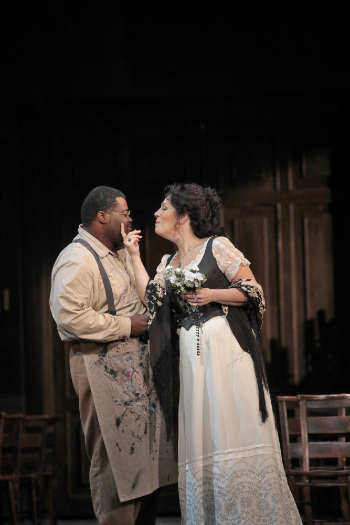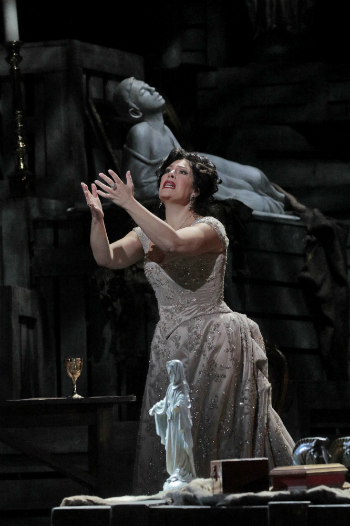Recently in Performances
English Touring Opera are delighted to announce a season of lyric monodramas to tour nationally from October to December. The season features music for solo singer and piano by Argento, Britten, Tippett and Shostakovich with a bold and inventive approach to making opera during social distancing.
This tenth of ten Live from London concerts was in fact a recorded live performance from California. It was no less enjoyable for that, and it was also uplifting to learn that this wasn’t in fact the ‘last’ LfL event that we will be able to enjoy, courtesy of VOCES8 and their fellow vocal ensembles (more below …).
Ever since Wigmore Hall announced their superb series of autumn concerts, all streamed live and available free of charge, I’d been looking forward to this song recital by Ian Bostridge and Imogen Cooper.
Although Stile Antico’s programme article for their Live from London recital introduced their selection from the many treasures of the English Renaissance in the context of the theological debates and upheavals of the Tudor and Elizabethan years, their performance was more evocative of private chamber music than of public liturgy.
Evidently, face masks don’t stifle appreciative “Bravo!”s. And, reducing audience numbers doesn’t lower the volume of such acclamations. For, the audience at Wigmore Hall gave soprano Elizabeth Llewellyn and pianist Simon Lepper a greatly deserved warm reception and hearty response following this lunchtime recital of late-Romantic song.
For this week’s Live from London vocal recital we moved from the home of VOCES8, St Anne and St Agnes in the City of London, to Kings Place, where The Sixteen - who have been associate artists at the venue for some time - presented a programme of music and words bound together by the theme of ‘reflection’.
'Such is your divine Disposation that both you excellently understand, and royally entertaine the Exercise of Musicke.’
‘And there was war in heaven: Michael and his angels fought against the dragon; and the dragon fought and his angels, And prevailed not; neither was their place found any more in heaven … that old serpent … Satan, which deceiveth the whole world: he was cast out into the earth, and his angels were cast out with him.’
There was never any doubt that the fifth of the twelve Met Stars Live in Concert broadcasts was going to be a palpably intense and vivid event, as well as a musically stunning and theatrically enervating experience.
‘Love’ was the theme for this Live from London performance by Apollo5. Given the complexity and diversity of that human emotion, and Apollo5’s reputation for versatility and diverse repertoire, ranging from Renaissance choral music to jazz, from contemporary classical works to popular song, it was no surprise that their programme spanned 500 years and several musical styles.
The Academy of St Martin in the Fields have titled their autumn series of eight concerts - which are taking place at 5pm and 7.30pm on two Saturdays each month at their home venue in Trafalgar Square, and being filmed for streaming the following Thursday - ‘re:connect’.
The London Symphony Orchestra opened their Autumn 2020 season with a homage to Oliver Knussen, who died at the age of 66 in July 2018. The programme traced a national musical lineage through the twentieth century, from Britten to Knussen, on to Mark-Anthony Turnage, and entwining the LSO and Rattle too.
With the Live from London digital vocal festival entering the second half of the series, the festival’s host, VOCES8, returned to their home at St Annes and St Agnes in the City of London to present a sequence of ‘Choral Dances’ - vocal music inspired by dance, embracing diverse genres from the Renaissance madrigal to swing jazz.
Just a few unison string wriggles from the opening of Mozart’s overture to Le nozze di Figaro are enough to make any opera-lover perch on the edge of their seat, in excited anticipation of the drama in music to come, so there could be no other curtain-raiser for this Gala Concert at the Royal Opera House, the latest instalment from ‘their House’ to ‘our houses’.
"Before the ending of the day, creator of all things, we pray that, with your accustomed mercy, you may watch over us."
The doors at The Metropolitan Opera will not open to live audiences until 2021 at the earliest, and the likelihood of normal operatic life resuming in cities around the world looks but a distant dream at present. But, while we may not be invited from our homes into the opera house for some time yet, with its free daily screenings of past productions and its pay-per-view Met Stars Live in Concert series, the Met continues to bring opera into our homes.
Music-making at this year’s Grange Festival Opera may have fallen silent in June and July, but the country house and extensive grounds of The Grange provided an ideal setting for a weekend of twelve specially conceived ‘promenade’ performances encompassing music and dance.
There’s a “slide of harmony” and “all the bones leave your body at that moment and you collapse to the floor, it’s so extraordinary.”
“Music for a while, shall all your cares beguile.”
The hum of bees rising from myriad scented blooms; gentle strains of birdsong; the cheerful chatter of picnickers beside a still lake; decorous thwacks of leather on willow; song and music floating through the warm evening air.
Performances

06 May 2017
Tosca: Stark Drama at the Chandler Pavilion
On Thursday evening April 27, 2017, Los Angeles Opera presented a revival of Giacomo Puccini’s Tosca at the Dorothy Chandler Pavilion. In 2013, director John Caird had given Angelinos a production that made Tosca a full-blooded, intense drama as well as a most popular aria-studded opera. His Floria was a dove among hawks.
Her lover, Cavaradossi, was an artist who preferred an out of favor political party and he helped hide an escaped political prisoner that Baron Scarpia, the chief of police, wanted to keep incarcerated. Scarpia was a womanizer who would have enjoyed a night with Tosca, after which he would have destroyed her as used goods. Caird did not pull any punches and he made his world every bit as brutal as that of twenty-first century television shows.
Scenic designer Bunny Christie showed us the appropriately dim Church of Sant’ Andrea della Valle with a three story high scaffolding that held Cavaradossi’s enormous madonna-in-progress. In Act II, Scarpia’s apartment in the Palazzo Farnese was filled with boxed and partially unpacked works of art, evoking the realization that the police chief stole art wherever he found it. For her last act, Christie designed an execution room atop the Castel Sant’Angelo that focused the sound of the voices.
With movie-star good looks and a large, silvery dramatic voice, Sondra Radvanovsky was the perfect embodiment of Puccini’s early nineteenth century opera singer. She colored her tones to fit each circumstance and emphasized the intensity of her emotions with the passionate phrases of “Vissi d’arte” (“I have lived for art”). Her character grew from the naïve ingénue in Act I to a reluctant killer in Act II. In Act III, she hoped for life with Cavaradossi in a new country. Having discovered Scarpia’s deception, she brazenly proclaimed her intent to meet him before God and jumped into eternity.

Puccini asks his tenor to sing the aria “Recondita armonia” (“Obscure harmony”) very soon after his first appearance on stage, and fully warmed up, Russell Thomas sang it with the golden sounds of a solid, well-honed tenor voice. I would like to hear more of him soon. Ambrogio Maestri was physically imposing and his manner made Scarpia a sadistic bully. The possessor of a powerful baritone voice, he sang with slightly rough bronze tones that underscored his character's unrefinment. Only when he offered Tosca holy water in the first act was he the slightest bit polite.
Scarpia’s aides, Brian Michael Moore as Spoletta and Daniel Armstrong as Sciarrone, followed his lead dramatically and sang with dark tones. Nicholas Brownlee, as Cesare Angelotti, however, had a much brighter sound and interpreted his character as though he might once again hold high office. Veteran bass-baritone Philip Cokorinos was an amusing Sacristan who gave just the right comedic touch to this tragic opera.
Conductor James Conlon brought out the drama of Puccini’s music in what is said to be his seventieth rendition of the opera. Thursday night’s show was only his second performance of the work in LA, however, and he showed this audience his distinctive, carefully crafted, richly detailed interpretation. Grant Gershon conducted the adult chorus and Anne Tomlinson directed the children’s group who led the jubilation of the Act I "Te Deum." Tosca is an opera that needs to be performed with significant individual interpretations and this was a fine representation of Puccini’s masterwork.
Maria Nockin
Cast and production information:
Conductor, James Conlon; Director, John Caird; Scenery and Costume Designer, Bunny Christie; Lighting Designer, Duane Schuler; Chorus Director, Grant Gershon; Director Los Angeles Children’s Chorus, Anne Tomlinson; Prompter, Miah Im; Cesare Angelotti, Nicholas Brownlee; Sacristan, Philip Cokorinos; Mario Cavaradossi, Russell Thomas; Floria Tosca, Sondra Radvanovsky; Baron Vitellio Scarpia, Ambrogio Maestri; Spoletta, Brian Michael Moore; Sciarrone, Daniel Armstrong; Jailer, Gabriel Vamvulescu.

